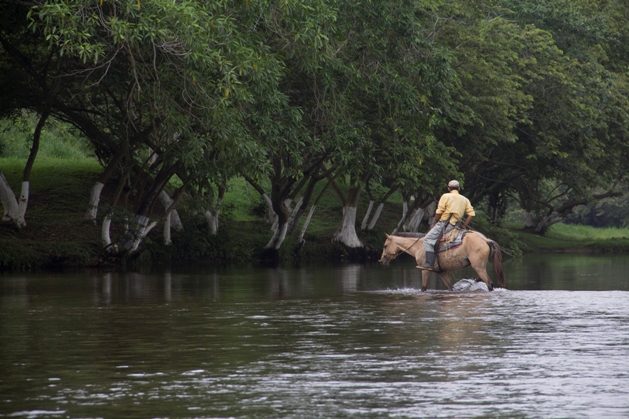Belize isn't really mountain country, but its offers some impressive rolling hills and highlands, some of the most beautiful of which are in Belize's western-most, largest, and most fertile district -- Cayo.
Geographically, the more than 2,000 square miles of this district offer everything from broad farmlands, gently rolling citrus orchards and cattle ranches to rugged mountains laced with caves and deep river gorges.
No wonder that along with agriculture, eco-tourism is now a mainstay of Cayo's economy. Tourists are drawn by the many caves, waterfalls, and Maya archeological sites... more sites than any other district in Belize. In fact, more than 60 percent of Cayo district is wildlife sanctuary, national park, or preserve.
You can reach the Cayo District in one-hour, driving from Belize City by good road. Most settlements in the district are in the Belize River valley, where the soil is fertile and waterways provide a means of traveling and transporting goods.
But up above 2,500 feet elevation, granite rock forms the Mountain Pine ridge, a section of pine forests, canyons, valleys, waterfalls, and one of the most popular eco tourist destinations in Belize.
The first small jungle lodges began operation around San Ignacio about 30 years ago. Now there are hotels, cottages and jungle lodges all around this area. Most expats who settle in Cayo will use San Ignacio, Cayo's biggest town and the second-largest city in Belize, as their commercial hub.
San Ignacio has grown to include Santa Elena, on the other side of the Macal River across Belize's only suspension bridge, the one-lane Hawksworth Bridge. Together, they're home to a mixed population of about 17,000 people.
San Ignacio has a character all its own. A taxi driver in Belize City told us once that San Ignacio is known for being home to Belize's friendliest people. It's 70 miles from the coast and just nine miles from the border with Guatemala. The population is a melting pot of Maya, Creoles, and Mestizos, Guatemalans, Mennonites, Lebanese and Chinese immigrants. Peace Corps volunteers, and archeologists working the nearby ruins and sites live here, too. Add in a growing number of North American retirees and you get something like an Old West frontier town...
In fact, San Ignacio looks something like an Old West town, with its wooden buildings and narrow streets. Burns Avenue serves as Main Street with shops, hotels and places to eat. Medical needs are met by the San Ignacio Hospital and the Loma Luz Adventist hospital in Santa Elena, and various other clinics, doctors and pharmacies.
Other population centers in Cayo include the national capital of Belmopan, established in 1965 after the former capital at Belize City was devastated by Hurricane Hattie. Belmopan is also the geographical center of Belize, 22 miles east of San Ignacio and 50 miles west of Belize City.
Another population center of Cayo is Spanish Lookout, midway between San Ignacio and Belmopan. It's Belize's most modern Mennonite community with about 3,000 inhabitants. The small houses and farmsteads spread out over open fields may remind you of rural Iowa or Illinois.
And between all these population centers and farmsteads are wild, natural areas of rivers, falls, caves and forests where jaguars hunt and scarlet macaws dart between the trees.
Why might you want to settle in Cayo? If you like wide open spaces and maybe want a plot of land to grow your own produce... and you're looking for a quiet, tranquil lifestyle... this may be your place. You're just a short distance from the ocean but it's a very different environment--and nighttime temperatures can be a bit more comfortable.
Plus, the cost of living is lower in Cayo than on the coast. We know expats who live here on as little as $1,500 to $2,000 a month.
And if you visit Cayo and want to connect with expats who live in the area, you'll often find them at local restaurants like Mr. Greedy's Pizza or the San Ignacio Seafood Shop. For sure you'll run into them in the grocery stores and around town. As for shopping, there are modern grocery stores with all the convenience foods you might want, and, of course, a local mercado where you can buy fresh locally grown fruits, vegetables, and more.
So what do expats do here? Many enjoy "giving back" to the local community. They become Rotary Club members, volunteer at schools, they've opened animal shelters, domestic abuse shelters, and more. And when they want a little R&R there are all kinds of outdoor activities to choose from. There's a big canoe race and a bicycle race in the spring and a festival of some kind just about every month.
So if you like your pace a little slower and your altitude a little higher, Cayo is one of the places in Belize that should be on your list. With enough activities and attractions to keep any outdoor enthusiast happy, Cayo is a natural for nature lovers looking for a place to call home.
Watch out for our upcoming blogs where we break down the country by destination and tell you what it's like to live there.
Related articles:
Part 2 Belize: Two of the Most Popular Retirement Spots
The Five Places Everyone Should Visit in Belize
A 6-Month Escape to Belize
The Freedom to Do Things Your Way in Belize


